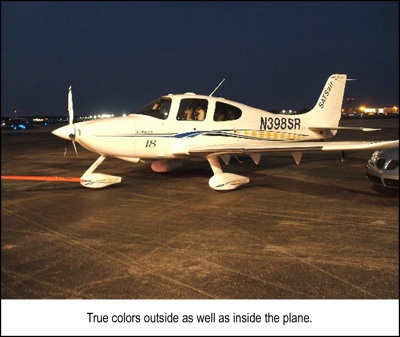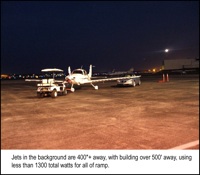
News
Products
RGB Fluorescent Lighting Systems – Shedding New Light on Quality, Energy and Maintenance
 Dec. 12, 2008 - Advanced RGB fluorescent lighting systems offer not only an attractive alternative to HID and other lighting sources, but can save enough on energy and replacement costs to pay for itself many times over.
Dec. 12, 2008 - Advanced RGB fluorescent lighting systems offer not only an attractive alternative to HID and other lighting sources, but can save enough on energy and replacement costs to pay for itself many times over.
December 12, 2008 By Administrator
The calamitous combination of through-the-roof energy costs and ever-mounting concerns about job safety, security and maintenance costs are raising concerns about lighting among architects, contractors, employers and the public.

|
All types of industrial, public, residential and commercial facilities are in need of new and retrofit light sources that are more reliable, energy-efficient and true-to-life. Fortunately, such a technology is available, creating significant opportunities for designers, contractors, managers and the public. Surprising to some, that technology is RGB fluorescent lighting.

|
Curiously, RGB fluorescent lighting is not a recent breakthrough. Although the technology is continually evolving, it has been in use by many applications for years. Yet, while offering distinct quality and cost advantages, fluorescent lighting has been perceived as old news, perhaps due to inadequate marketing.
Ironically, “newer” technologies such as HID (high intensity discharge) lighting have been viewed as advanced, even though they are inefficient and poor in quality compared to fluorescent sources. In fact, HID is quickly becoming the Hummer of lighting: powerful and imposing, but hardly appropriate for meeting pressing needs to conserve on energy and maintenance costs.
“Even though HID lights may appear to be quite bright, they are also very expensive to operate in terms of energy and maintenance,” says Bob Malone, president of Malone Controls (San Jose, CA), a Silicon Valley-based firm that designs and installs controls and other energy-related systems. “The quality is also sporadic, both in terms of intensity and lighting, color and glare . . . and coverage as you get farther from the source or as the lights get older.”
A true-to-life source
Malone is among an upsurge of lighting experts and customers who are increasingly specifying and installing fluorescent lighting for new and retrofit applications ranging from industrial to residential and public spaces.
Not only is fluorescent lighting much less expensive to operate than other lighting technologies (although LED will have its place in the future), high-quality fluorescent fixtures and an RGB lamp can provide visual characteristics that makes it a fundamentally superior light source.
“The quality of light is far more important than the quantity of light,” explains Larry Leetzow, president, Magnaray® International (Sarasota, FL), a manufacturer and marketer of high-quality fluorescent lighting systems. “The quality of light is its trueness to the daylight that we see with or eyes.
The human eye has three photoreceptors, red, blue and green (hence RGB), just like computer displays and televisions. When combined, the red, blue and green light frequencies make white light that enables people to see more normally. RGB fluorescent light sources can produce that light, which is far more balanced and normal than the yellow light frequencies produced by low-sodium lights, for instance.”
Ron Ciaravella, president of Dolphin Aviation (Sarasota, FL), agrees. For the past 30 years he has operated a full-service general aviation facility at the Sarasota-Bradenton International Airport that offers 24-hour transient services to non-airline and general aviation aircraft. Dolphin Aviation illuminates a 15-acre aircraft ramp throughout the night so that taxiing aircraft can approach the facility safely.
“In the past, we used mercury-vapor lights to illuminate the ramp,” Ciaravella says. “The light was bright around the fixture, but the farther away you were, the more dissipated the light became; your eyes had to adjust to light and dark spots in different areas of the ramp. With the Magnaray fluorescent array, we get consistent levels of lighting across the entire ramp, while using the same number of fixtures which produce considerably fewer lumens (units of light).”
Seeing the light on savings
Because illumination systems such as Magnaray’s fluorescent fixtures and lamps require fewer lumens to produce “whiter” RGB light, they use substantially less energy – enough to easily pay for a new or retrofit system in a relatively short time.
At Dolphin Aviation, the outright savings has been substantial. “I believe the Magnaray light uses 40% less energy than the contemporary mercury-vapor light,” Ciaravella says. “The light is spread evenly over the entire ramp, and is much friendlier to the eye. We also have control over each lamp in the fluorescent array, thereby allowing us to reduce the intensity to meet our lighting needs for any particular time, while saving money.”
Similarly dramatic energy savings have been enjoyed by a diverse variety of businesses and institutions using Magnaray fluorescent systems, including border patrol installations, department stores, military bases, recreational and parking facilities.
Across the board these installations have experienced enhanced savings through extraordinarily low maintenance and replacement costs.
Total savings include a “green” payoff in terms of both energy savings and lower use of consumables such as lamps. The EPA states that 1.3077 lbs of carbon dioxide, 1.93 grams of sulfur and 1.63 grams of nitric oxide are saved for every kilowatt-hour of energy not used due to the fluorescent lighting’s greater efficiency. Over the years the company estimates that its products have saved enough pollution for the removal of 2,250,000 cars from the road and the need to grow 3,068,322 acres of trees.
Plus, because today’s advanced fluorescent lighting systems may be automatically controlled by motion sensors and are instant-on, my applications that require only periodic lighting, such as warehouses and other industrial applications, savings on energy is even further enhanced.
Since 1964, Magnaray, a division of the World Institute of Lighting and Development Corporation, has been improving on commercial and industrial safety, security and productivity while lowering maintenance and energy costs as well as greenhouse gases, through advanced outdoor and indoor fluorescent lighting systems.
For more information contact Magnaray International, 2242 Whitfield Park Loop, Sarasota, FL 34243; Mail: P.O. Box 990, Bradenton, FL 34206; Phone: (941) 755-2111; Fax (941) 751-5483; E-mail: sales@magnaray.com; Visit the web site: www.magnaray.com